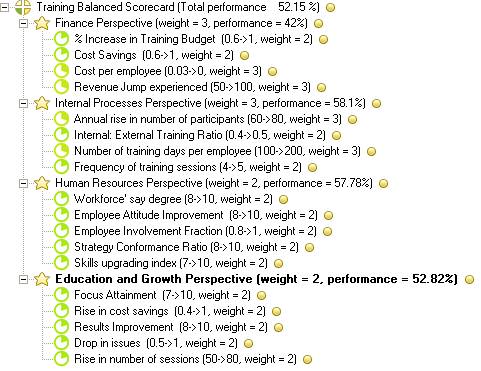Key Performance indictors to estimate training
process
It universally acknowledged that training forms a significant way for managers to contribute for enhancement of 'skill set' of their employees. Among the benefits that are realized include 'improved operations' and 'increased motivation level' of participants. Such reasons make up for enough causes to compel top level management to organize similarly meaningful interactions. These training sessions perform the task of keeping their participants updated about the traits that are presently appreciated in the concerned industry. Such awareness fuels the competitive desire of work staff, thereby preparing them to pour in even greater amounts of talent towards organizational welfare. Consequently, several industry leaders are frequently found engaged in making such arrangements for their taskforce.
Training KPI - how to design training KPI step by step:
Business Problem. Though training more often than not is suggested to increase the skill of the employees, it results often fall short of expectations. To make training really useful, a true and detailed understanding about the gap that exists between 'industrial requirements' and 'current state of employees' is to be carried out. Once this task is accomplished honestly and needs are laid out in a stepwise manner, it gets easier to incorporate the revelations in training programs. Thus, the chances of training offering the very exact 'impact' go up manifold.
Solution with KPI. Moving on, just like any 'management oriented path' cannot be 'pitfall-proof', this too is not an exception. This is to say that the route is studded with many roadblocks. Among the several hurdles faced during the implementation phase of training, one pertains to 'laying down accurate targets that are to be achieved'. This is required for obvious reasons as only then one can compare the 'actual state' with 'desired' one. This job in turn can be attained by introducing 'BSC' (Balanced Scorecard) in the process. The basic idea behind this strategy is to formulate the areas (that are to be improved) in terms of indicators to which values can be assigned. Such carefully structured set of parameters serves the purpose of 'keeping a track' of the steps and moves being undertaken. One can collect different KPIs to be kept under various categories that are deemed meaningful in training scenario.

The user has to reach the very nerve of concerned process for construction of any strategy aiming at improvising the current situation. Post this act of understanding the business task, business problems are to be figured out as one can make the surface smooth only after knowledge about the rough patches has been gained.
The solution lies with 'KPI contained BSC'. The quantitative approach promoted by this 1990s strategy has turned around the fortunes of several organizations by giving the transparency of operations a sudden and much desired 'push'. One can make use of this thought for 'counting' the aspects involved and subsequently digging ways to improve on the deficiencies in case of 'training' also. Thus, solution with KPI will be towards identifying the target processes and achieving the target results.
Expected Results
Saying it all in a nutshell, one has to 'get in it to win it'. This is because only when the hidden dynamics of any process have been laid bare that improvement in it is made possible. KPIs, in this direction go a long way in creating the needed grasp of difficulty lying ahead. Some of the key results that one can quickly expect include brisk improvement in skill level, tracking of how effort made in training is generating results and possible ideas to refine training process.
|